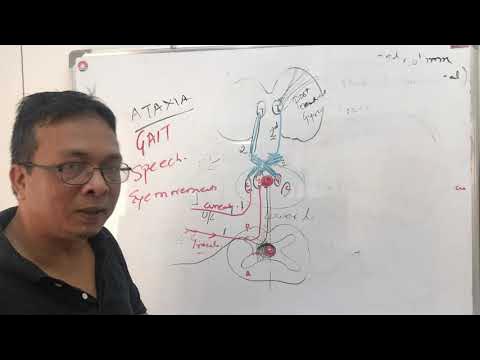Sensation from the Body: Neuroanatomy Video Lab - Brain Dissections
Summary
TLDRThis video explores two essential sensory pathways in the body: the anterolateral (spinothalamic) system and the dorsal column medial lemniscus system. It details how these pathways transmit sensory information such as pain, temperature, fine touch, vibration, and joint position from the body to the brain. Key differences are highlighted, including where the pathways cross over and their neural organization. The video also delves into the anatomy of the spinal cord, brainstem, and sensory cortex, explaining the somatotopic map and the implications of lesions in these pathways for sensory perception, including sensory dissociation.
Takeaways
- 😀 The two main sensory pathways in the body are the anterolateral system (spinothalamic tract) and the dorsal column medial lemniscus system.
- 😀 The anterolateral system (spinothalamic tract) carries information about pain and temperature, while the dorsal column system is responsible for fine touch, two-point discrimination, vibration, and joint position.
- 😀 Both sensory pathways carry crude touch, but the pathways for pain and temperature cross to the opposite side of the body earlier (in the spinal cord) than the pathways for fine touch and vibration, which cross in the medulla.
- 😀 Sensory information from the right side of the body is processed in the left side of the brain, and vice versa.
- 😀 The dorsal root ganglia are the locations of the primary sensory neurons for both pathways, where they enter the spinal cord.
- 😀 The spinothalamic pathway crosses almost immediately in the spinal cord, while the dorsal column medial lemniscus pathway ascends on the same side until the caudal medulla, where it crosses.
- 😀 The somatotopic organization is maintained throughout the entire pathway, with specific areas of the body represented in specific regions of the brain.
- 😀 In the medulla, the spinothalamic pathway forms the green tract and the dorsal column pathways form the medial lemniscus, which is blue in the diagram.
- 😀 The spinothalamic tract is located more laterally, while the dorsal column fibers are located medially in the brainstem and higher regions.
- 😀 Sensory dissociation can occur when lesions affect the sensory pathways differently, causing a loss of pain and temperature sensation without affecting fine touch and vibration, or vice versa.
Q & A
What are the two main sensory pathways discussed in the script?
-The two main sensory pathways discussed are the anterolateral system (spinothalamic tract) and the dorsal column medial lemniscus system.
What types of sensation are carried by the spinothalamic tract?
-The spinothalamic tract carries sensations related to pain and temperature.
Which sensations are carried by the dorsal column medial lemniscus system?
-The dorsal column medial lemniscus system carries sensations related to fine touch, two-point discrimination, vibration, and joint position.
How does the spinothalamic tract differ from the dorsal column in terms of where they cross to the opposite side of the body?
-The spinothalamic tract crosses to the opposite side of the body almost immediately upon entering the spinal cord, while the dorsal column medial lemniscus system crosses at the caudal medulla.
Where does the second neuron of the spinothalamic tract synapse, and how does it relate to the first neuron?
-The second neuron of the spinothalamic tract synapses in the spinal cord, very close to where the first neuron enters, and the second neuron crosses to the opposite side of the body.
Where does the second neuron of the dorsal column medial lemniscus system synapse?
-The second neuron of the dorsal column medial lemniscus system synapses in the caudal medulla, before crossing to the opposite side.
What is the somatotopic organization of the dorsal column system in the spinal cord?
-In the dorsal column system, the sensory information from the lumbar and sacral regions is more medial, while information from the hands and neck is more lateral.
What is the significance of the medial lemniscus in the medulla?
-The medial lemniscus is formed when the second-order neurons of the dorsal column system cross to the opposite side in the caudal medulla, and it carries sensory information to the thalamus.
How are the pathways for pain/temperature and fine touch organized in the brainstem?
-In the brainstem, the spinothalamic tract (pain/temperature pathway) is more lateral, while the medial lemniscus (fine touch, vibration, joint position) is more medial. They remain separate until they approach the thalamus.
How does damage to different parts of the sensory pathways affect sensation?
-Damage to the sensory pathways can lead to sensory dissociation, where a person may lose pain and temperature sensation but retain fine touch, vibration, or joint position sensation, or vice versa, depending on the location of the lesion.
Outlines

Dieser Bereich ist nur für Premium-Benutzer verfügbar. Bitte führen Sie ein Upgrade durch, um auf diesen Abschnitt zuzugreifen.
Upgrade durchführenMindmap

Dieser Bereich ist nur für Premium-Benutzer verfügbar. Bitte führen Sie ein Upgrade durch, um auf diesen Abschnitt zuzugreifen.
Upgrade durchführenKeywords

Dieser Bereich ist nur für Premium-Benutzer verfügbar. Bitte führen Sie ein Upgrade durch, um auf diesen Abschnitt zuzugreifen.
Upgrade durchführenHighlights

Dieser Bereich ist nur für Premium-Benutzer verfügbar. Bitte führen Sie ein Upgrade durch, um auf diesen Abschnitt zuzugreifen.
Upgrade durchführenTranscripts

Dieser Bereich ist nur für Premium-Benutzer verfügbar. Bitte führen Sie ein Upgrade durch, um auf diesen Abschnitt zuzugreifen.
Upgrade durchführenWeitere ähnliche Videos ansehen

Sensory Pathways MADE EASY!!

Spinal Cord Mnemonics (Memorable Neurology Lecture 8)

As grandes vias aferentes e eferentes: Introdução e vias aferentes - Parte 1

Ascending and Descending Spinal Cord Tracts Made Easy

DCML(dorsal column medial lemniscal):Rhomberg's test,posterior cord syndrome,Friedrich's Ataxia

NEUROFISIOLOGIA - AS GRANDES VIAS AFERENTES E EFERENTES - Prof Mara Ribeiro - Aula 13
5.0 / 5 (0 votes)
